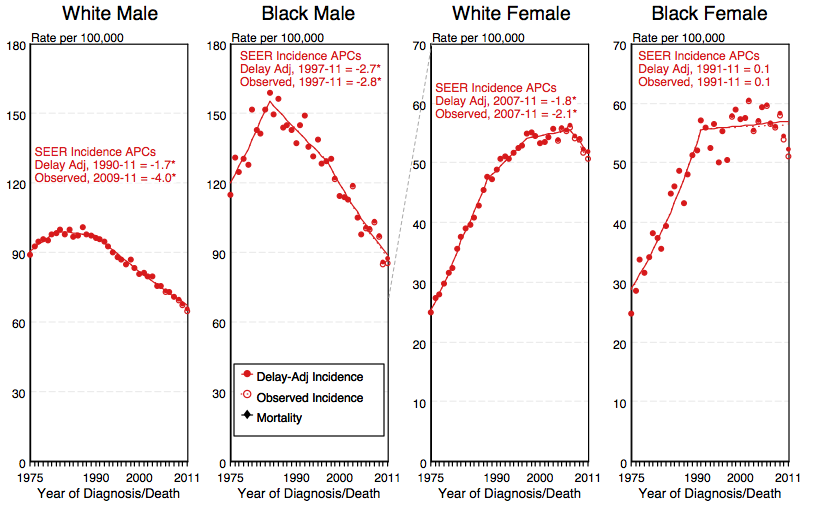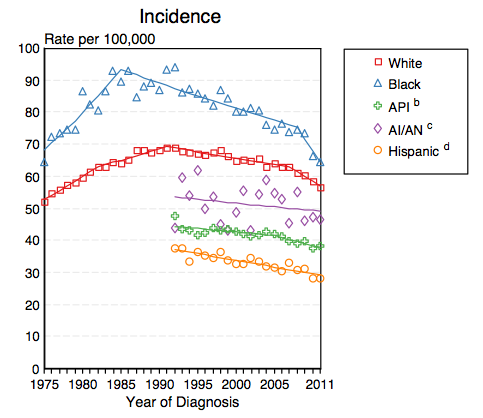Lung cancer epidemiology and demographics: Difference between revisions
Rim Halaby (talk | contribs) No edit summary |
Rim Halaby (talk | contribs) |
||
| Line 35: | Line 35: | ||
** Under 65 years: 18.1 per 100,000 | ** Under 65 years: 18.1 per 100,000 | ||
** 65 and over: 349.9 per 100,000 | ** 65 and over: 349.9 per 100,000 | ||
===Gender=== | ===Gender=== | ||
Revision as of 01:45, 11 June 2014
|
Lung cancer Microchapters |
|
Diagnosis |
|---|
|
Treatment |
|
Case Studies |
|
Lung cancer epidemiology and demographics On the Web |
|
American Roentgen Ray Society Images of Lung cancer epidemiology and demographics |
|
Risk calculators and risk factors for Lung cancer epidemiology and demographics |
Editor-In-Chief: C. Michael Gibson, M.S., M.D. [1]; Associate Editor(s)-In-Chief: Kim-Son H. Nguyen, M.D., M.P.A., Beth Israel Deaconess Medical Center, Harvard Medical School, Boston MA; Cafer Zorkun, M.D., Ph.D. [2]; Rim Halaby, M.D. [3]; Assistant Editor(s)-In-Chief: Michael Maddaleni, B.S.
Overview
Worldwide, lung cancer is the most common cancer in terms of both incidence and mortality with 1.35 million new cases per year and 1.18 million deaths. The highest rates are observed in Europe and North America. The population segment most likely to develop lung cancer is those individuals over-fifty years of age who have a history of smoking. Although the rate of men dying from lung cancer is declining in western countries, it is actually increasing for women due to their increased rate of smoking. Among lifetime non-smokers, men have higher age-standardized lung cancer death rates than women. The expected number for new cases of lung cancer in the United States for 2014 is 224,210.[1]
Epidemiology and Demographics
Prevalence
In the United States, the age adjusted prevalence of cancer of the lungs and bronchus is 0.1004 % in 2011.[2]
Prevalence by Cause
Smoking
Smoking, particularly of cigarettes, is by far the main contributor to lung cancer. In the United States, smoking is estimated to account for 87% of lung cancer cases (90% in men and 85% in women).[3] It should also be noted that approximately 15 years after quitting smoking, the risk of lung cancer approaches that of a nonsmoker.
By the year 2030, the World Health Organization (WHO) projects that tobacco related deaths will hit an annual death rate of 3 million people in industrialized countries and 7 million in developing countries[4].
Radon Gas
Radon gas is the cause of approximately 15,000 to 22,000 deaths per year or 12% of the total number of lung cancer deaths per year. Radon gas is the second major cause of lung cancer behind smoking.
Radon gas levels vary by locality and the composition of the underlying soil and rocks. For example, in areas such as Cornwall in the UK (which has granite as substrata), radon gas is a major problem, and buildings have to be force-ventilated with fans to lower radon gas concentrations. The United States Environmental Protection Agency (EPA) estimates that one in 15 homes in the U.S. has radon levels above the recommended guideline of 4 picoCuries per liter (pCi/L).[5] Iowa has the highest average radon concentration in the United States; studies performed there have demonstrated a 50% increased lung cancer risk with prolonged radon exposure above the EPA's action level of 4 pCi/L.[6][7]
Asbestos
Asbestos related lung cancer is rarer than radon gas or smoking. It accounts for approximately 3,400 to 8,500 cases per year in the United States. In the UK, asbestos accounts for 2–3% of male lung cancer deaths.[8]
Incidence
- The delay-adjusted incidence of invasive cancer of the lungs and bronchus in 2011 was estimated to be 56.64 per 100,000 persons in the United States.[2]
- In 2011, the age-adjusted incidence of invasive cancer of the lungs and bronchus was 55.50 per 100,000 persons in the United States.[2]
Age
- While the overall age adjusted incidence of cancer of the lungs and bronchus in the United States between 2007 and 2011 is 60 per 100,000, the age-adjusted incidence of (insert disease state here) by age category is:[2]
- Under 65 years: 18.1 per 100,000
- 65 and over: 349.9 per 100,000
Gender
- In the United States, the age adjusted prevalence of cancer of the lungs and bronchus by gender in 2011 is:[2]
- In males: 0.1036 %
- In females: 0.985 %
- In the United States, the delay-adjusted incidence of cancer of the lungs and bronchus by gender in (insert year here) is:[2]
- In males: 66.17 per 100,000 persons
- In females: 49.62 per 100,000 persons
- In the United States, the age-adjusted incidence of cancer of the lungs and bronchus by gender on (insert year here) is:[2]
- In males: 64.83 per 100,000 persons
- In females: 48.63 per 100,000 persons
Shown below is an image depicting the observed incidence and delay-adjusted incidence of cancer of the lungs and bronchus by gender and race in the United States between 1975 and 2011.[2]
Gender and Smoking
Among male smokers, the lifetime risk of developing lung cancer is 17.2%. Among female smokers, the risk is 11.6%. This risk is significantly lower in non-smokers: 1.3% in men and 1.4% in women.[9]
Race
- In the United States, the age adjusted prevalence of cancer of the lungs and bronchus by race in 2011 is:[2]
- In all races: 0.1004 %
- In white: 0.1031 %
- In black: 0.1092 %
- In Asian/pacific islander: 0.0781 %
- In Hispanic: 0.0499 %
Shown below is an image depicting the incidence of cancer of the lungs and bronchus by race in the United States between 1975 and 2011.[2]
Percent Distribution of Cancer of the Lungs and Bronchus by Histology
Among patients with histologically confirmed cases of cancer of the lungs and bronchus, the percent distribution of the types of the disease between 2004 and 2010 in the United States are:[2]
- Carcinoma: 99.7%
- Small cell carcinoma: 13.4 %
- Non small cell carcinoma: 83.2 %
- Squamous or transitional: 22%
- Adenocarcinoma: 41.5%
- Large cell: 2.3%
- Non small cell carcinoma: 12.6%
- Other specified carcinoma: 4.8%
- Carcinoma not otherwise specified:3.2%
- Sarcoma: 0.2 %
- Other specified types: 0.1%
Developed Countries
Eastern Europe has the highest lung cancer mortality among men, while northern Europe and the U.S. have the highest mortality among women. Lung cancer incidence is currently less common in developing countries.[10]
Developing Countries
With increased smoking in developing countries, the incidence is expected to increase in the next few years, notably in China[11] and India.[12]
References
- ↑ Siegel, Rebecca; Ma, Jiemin; Zou, Zhaohui; Jemal, Ahmedin (2014). "Cancer statistics, 2014". CA: A Cancer Journal for Clinicians. 64 (1): 9–29. doi:10.3322/caac.21208. ISSN 0007-9235.
- ↑ 2.00 2.01 2.02 2.03 2.04 2.05 2.06 2.07 2.08 2.09 2.10 Howlader N, Noone AM, Krapcho M, Garshell J, Miller D, Altekruse SF, Kosary CL, Yu M, Ruhl J, Tatalovich Z,Mariotto A, Lewis DR, Chen HS, Feuer EJ, Cronin KA (eds). SEER Cancer Statistics Review, 1975-2011, National Cancer Institute. Bethesda, MD, http://seer.cancer.gov/csr/1975_2011/, based on November 2013 SEER data submission, posted to the SEER web site, April 2014.
- ↑ Samet, JM (May 1988). "Cigarette smoking and lung cancer in New Mexico". American Review of Respiratory Disease. 137 (5): 1110–1113. PMID 3264122. Unknown parameter
|coauthors=ignored (help) - ↑ Kenfield SA, Stampfer MJ, Rosner BA, Colditz GA (2008). "Smoking and smoking cessation in relation to mortality in women". JAMA : the Journal of the American Medical Association. 299 (17): 2037–47. doi:10.1001/jama.299.17.2037. PMC 2879642. PMID 18460664. Retrieved 2011-12-19. Unknown parameter
|month=ignored (help) - ↑ EPA (Oct 2006). "Radiation information: radon". EPA. Retrieved 2007-08-11.
- ↑ Field, RW (Jun 2000). "Residential radon gas exposure and lung cancer: the Iowa Radon Lung Cancer Study". American Journal of Epidemiology. Oxford Journals. 151 (11): 1091–1102. PMID 10873134. Retrieved 2007-08-11. Unknown parameter
|coauthors=ignored (help) - ↑ EPA (Jun 2000). "Iowa Radon Lung Cancer Study". EPA. Retrieved 2007-08-11.
- ↑ Darnton, AJ (Jan 2006). "Estimating the number of asbestos-related lung cancer deaths in Great Britain from 1980 to 2000". Annals of Occupational Hygiene. 50 (1): 29–38. PMID 16126764. Retrieved 2007-09-07. Unknown parameter
|coauthors=ignored (help) - ↑ Villeneuve, PJ (Nov 1994). "Lifetime probability of developing lung cancer, by smoking status, Canada". Canadian Journal of Public Health. 85 (6): 385–388. PMID 7895211. Unknown parameter
|coauthors=ignored (help) - ↑ "Gender in lung cancer and smoking research" (PDF). World Health Organization. 2004. Retrieved 2007-05-26.
- ↑ Liu, BQ (Nov 1998). "Emerging tobacco hazards in China: 1. Retrospective proportional mortality study of one million deaths". British Medical Journal. 317 (7170): 1411–1422. Retrieved 2007-09-27. Unknown parameter
|pmidbr=ignored (help); Unknown parameter|coauthors=ignored (help) - ↑ Behera, D (2004). "Lung cancer in India". Indian Journal of Chest Diseases and Allied Sciences. 46 (4): 269–281. PMID 15515828. Unknown parameter
|coauthors=ignored (help)

